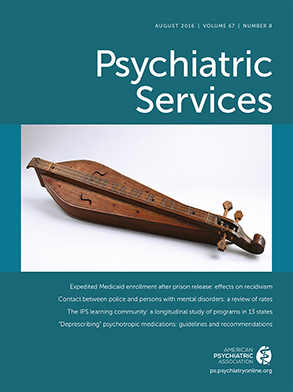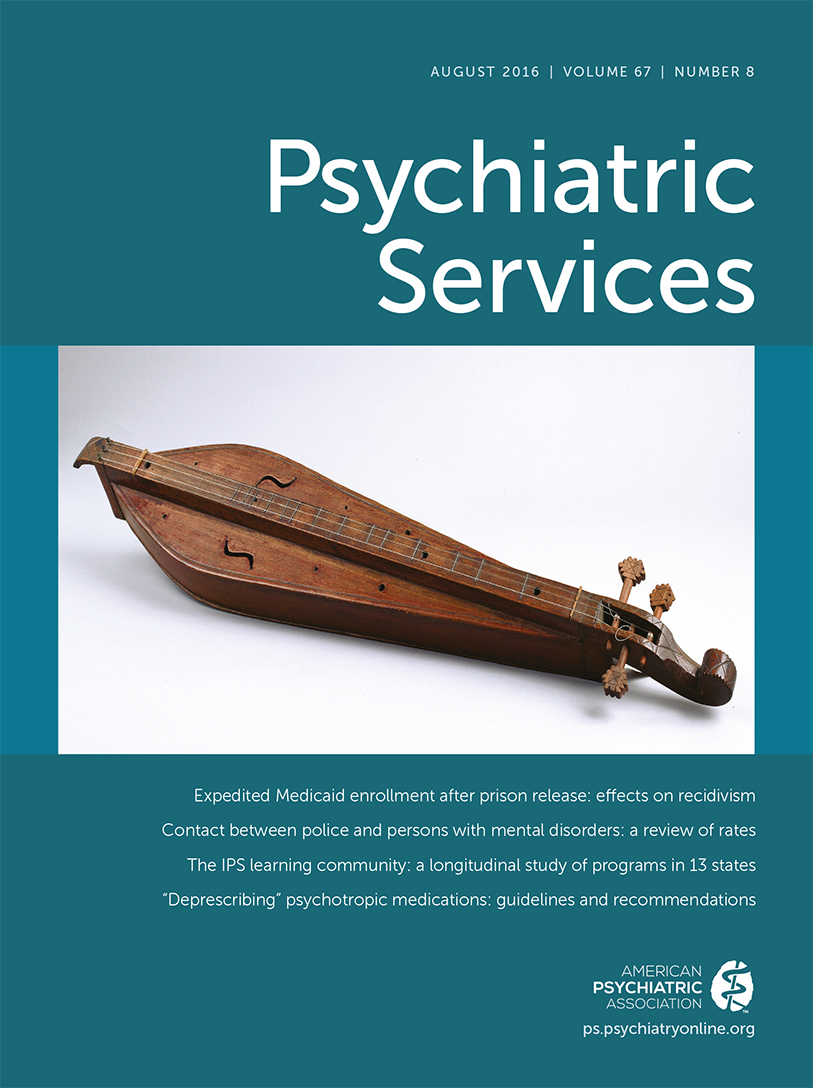Perinatal depression—major depressive disorder occurring during pregnancy or within one year of delivery—has deleterious effects on birth outcomes (
1), infant attachment, and child behavior and development (
2). Up to one in six women suffer from perinatal depression (
3). Despite availability of effective evidence-based treatments and frequent contact with obstetric providers, less than 25% of perinatal women who screen positive for depression receive treatment (
4). Barriers at the patient, provider, and systems levels prevent perinatal women and obstetric providers from addressing depression (
5).
Incorporating depression care into routine obstetrical practice may provide a solution to this critical public health issue. Integrated care models have been shown to effectively incorporate depression treatment in primary care settings, thereby improving the quality of mental health care and depression outcomes (
6). Studies exploring such models in obstetric settings demonstrate both the promise and limitations of available approaches (
5). Even if they are effective, collaborative care approaches are expensive to implement and difficult to sustain (
7,
8). They depend on care management, which is not reliably reimbursed, and, therefore, broad dissemination of these models and associated treatment improvement are not realized (
7). The term “voltage drop” has been used to describe diminished impact of collaborative care approaches when implemented in low-resource real-world settings (
8). Thus sustainable models for depression care in obstetric settings that optimize existing services for pregnant women with depression are needed.
We designed and beta tested implementation of a new program, the PRogram In Support of Moms (PRISM). Unlike typical collaborative care models, PRISM leverages providers and staff already working in obstetric settings to identify and treat perinatal depression. PRISM aims to improve treatment participation and depression outcomes among perinatal women by helping obstetric practices to detect, assess, and refer or treat perinatal depression. This column describes the development of PRISM and lessons learned about barriers and facilitators to implementation during beta testing in an obstetric practice.
PRISM: Implementation and Beta Testing
An obstetric practice at a large academic tertiary care referral center in central Massachusetts collaborated on PRISM’s development. A multidisciplinary work group consisting of a purposeful sample of health care professionals and support staff—six perinatal and one psychiatric—from the practice was convened. [More details on the work group are presented in an online supplement to this column.] Goals and strategies for addressing perinatal depression were identified. The work group provided iterative feedback on program components by discussing barriers and facilitators to PRISM implementation.
Components.
To help obstetric practices implement PRISM, the following implementation strategies from the Addressing Problems Through Organizational Change (
9) model are used: engage practice providers, leaders, and staff; identify champions and prepare for change; assess readiness for PRISM implementation; identify steps to achieve goals; implement PRISM components into the practice; and support, encourage, and sustain change.
Access to mental health consultation with a perinatal psychiatrist to guide treatment provision is provided via e-mail or telephone. Consultation may involve diagnostic support; guidance about medication treatment; advice on psychotherapy and community supports; treatment planning recommendations; and information about medication risks during preconception, pregnancy, and lactation. Consulting perinatal psychiatrists assist the provider in addressing patients’ mental health concerns.
A 1.5-hour training session is conducted for practice providers and staff to build their capacity to screen and assess depression, include depression in treatment plans, and discuss the risks and benefits of antidepressant use during pregnancy and lactation. Providers also receive training and resources to help destigmatize depression and activate women to seek help. Practices are provided with a toolkit that includes screening, referral, and treatment protocols. [See online supplement for toolkit details.]
A practice-specific approach to depression screening is developed. This includes determining the timing, location, and setting for screening and discussion of screening, treatment, and referral. Providers and staff are trained to offer psychoeducation and mental health resources and referrals during obstetric visits.
Beta testing.
The evaluation protocol was reviewed by the University of Massachusetts Medical School’s Institutional Review Board and received an exemption. Baseline screening was assessed prior to the study by asking obstetric providers and staff, “Do you routinely screen for perinatal depression using a validated screening tool?” All obstetric attending and resident physicians and nursing and front-desk staff working at the practice were invited to attend a training session. A beta test was then conducted at the practice site on Mondays from November through December 2013. During this period, 50 patients were served by the obstetric providers and staff participating in the beta test.
For the screening component, the participating providers and staff invited the pregnant and postpartum women receiving care to be screened with the Edinburgh Postnatal Depression Scale (EPDS) (
10). The EPDS is a validated and widely used, self-administered screening questionnaire that is administered during pregnancy and postpartum. The total score ranges from 0 to 30, with higher scores indicating greater symptom severity. The cutoff scores used to indicate possible depression range from 9 to 13. We used a cutoff of ≥10 to identify most or all women with symptomatology indicating that further assessment was warranted. When the EPDS was completed, providers followed the PRISM screening protocol and utilized the program components. The first author served as the psychiatric consultant.
Provider and staff participation in and their perceptions of PRISM were assessed via a training attendance log, medical record review, and a telephone consultation call or an e-mail log. A 90-minute audiotaped focus group was also conducted with a purposeful sample of obstetric providers and staff to identify barriers and facilitators to implementation of PRISM [see online supplement]. Participants responded to open-ended study probes on barriers and facilitators to addressing perinatal depression. Interview data were coded by two authors (NB and SH) for concepts and themes. Within this framework, increasingly narrow and specific categories of concepts and themes were defined to condense raw data and identify common themes.
Beta testing outcomes.
Participants consisted of a multidisciplinary group of obstetric providers and staff. Prior to beta testing, all 14 of the provider and staff participants answered “no” to the question, “Do you routinely screen for perinatal depression using a validated screening tool?”
Ninety-three percent (N=13) of the providers and staff in the practice attended the training. Of the 50 women served, 40 (80%) completed the EPDS. The EPDS was documented in the medical record for 95% of patients screened (N=38). Fourteen of the 40 screened patients (35%) scored ≥10. No patient scored positive on the EPDS self-harm question. Every participating obstetric provider screened at least 50% of his or her patients; as noted above, none were screening systematically before implementation. The consulting psychiatrist provided four consultations about assessment or treatment of perinatal depression to obstetric providers by phone or e-mail.
Focus group findings.
Provider and staff participants noted that PRISM components need enhancements to promote patient completion of the EPDS screen and engagement in mental health care. They also noted that the EPDS revealed symptoms that they would not have otherwise detected, which reinforced the importance of screening. Clinic-specific tailoring of PRISM was noted to facilitate screening, assessing, referring for treatment, or treating depression. One nurse explained, “You had our input about how the practice ran before you [implemented screening]. . . . You used us for feedback and input and that was very important.” Participants also noted that access to consultation with a perinatal psychiatrist facilitated screening and management of depression by obstetric providers and staff. An obstetric resident noted, “We also feel like we’re supported, so it’s easier to start [treatment] when you have someone who is in the specialty that can back you up.”
Discussion and Conclusions
Beta testing and initial evaluation of PRISM found preliminary evidence of acceptability in an obstetric practice. We demonstrated that it is feasible to use training and implementation assistance to help obstetric providers and staff implement a multicomponent program to incorporate depression screening and treatment into obstetric care. This builds on prior studies suggesting that the capacity of obstetric professionals to detect and address depression is enhanced when they are provided with education, resources, and access to mental health consultation (
5). The most potent facilitators to addressing depression appear to be practice-specific tailoring of the PRISM components, knowledge and skills obtained during training, and access to real-time consultation with a perinatal psychiatrist.
Addressing perinatal depression needs a financially sustainable platform. One model of a sustainable program, which addresses a different mental health need in the community, is offered by the Massachusetts Child Psychiatry Access Project (MCPAP). MCPAP is a population-based model that, like PRISM, uses real-time consultation with psychiatrists (in this case child psychiatrists) to help pediatricians manage psychiatric concerns. MCPAP has been widely implemented across the United States. In 2014, the Massachusetts legislature added budgetary language stating that commercial insurers will be surcharged proportionately for their utilization of MCPAP programs (
11).
The need to further improve PRISM to better engage women makes sense given prior studies indicating that empathic depression screening and discussion of mental health concerns are critical to engaging women in mental health care (
5). This is consistent with prior work suggesting that both providers and patients need to be trained and empowered to participate in screening, assessment, and treatment of depression in obstetric settings to prevent women in need from falling through the cracks in the depression care pathway (
5).
The process described has several strengths and weaknesses. A strength is the iterative provider and staff feedback used to develop and tailor PRISM for real-world settings. To be sustainable, PRISM utilizes existing clinical resources rather than research-funded resources to screen and address depression, increasing the potential for real-world implementation. Based on the feedback, PRISM will be enhanced to include patient engagement strategies, proactive tracking of patients who screen positive for depression, and a stepped-care treatment response to depression screening and assessment.
A limitation is that we worked only with one practice in one academic medical center. However, this allowed us to develop a critical process for tailoring PRISM implementation that can be translated to other practice sites. In addition, no patient participants endorsed suicidal ideation; it will be important to assess PRISM in the context of patients with more severe symptoms. It is also likely that other challenges will occur with different patient populations, providers and staff, and clinical settings. We also do not have follow-up data on women’s adherence to depression care and improvement in depression symptoms. Thus we are unable to link the screening and referral process to outcomes. PRISM was also tested for a short period, and we were unable to determine whether implementation will be sustained. Future work is needed to evaluate PRISM in diverse clinical settings, evaluate patient outcome data, and enrich our understanding of patient perceptions of screening.
Beta testing outcomes suggest that addressing perinatal depression in obstetric settings is a complex process that requires clinic-specific tailoring of interventions to help obstetric clinics address depression, access to training and consultation to build obstetric provider and staff capacity to treat individual patients, and patient-specific strategies to help with treatment engagement. Although further evaluation is indicated, PRISM shows promise for overcoming patient-, provider-, and clinic-level barriers to addressing perinatal depression in obstetric settings.

